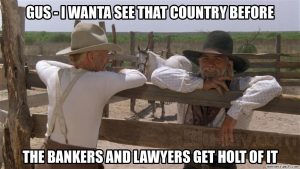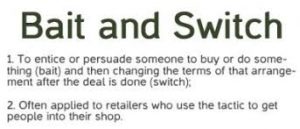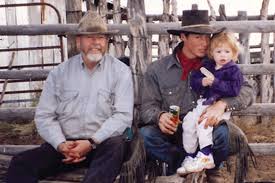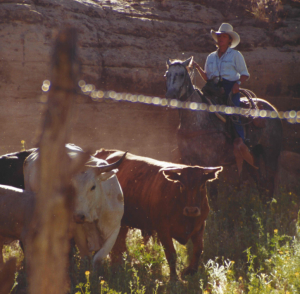First published in Range magazine.
“We hold these truths to be self-evident, that all men are created equal, that they are endowed by their Creator with certain unalienable rights, that among these are Life, Liberty and the Pursuit of Happiness… But when a long train of abuses and usurpations, pursuing invariably the same Object evinces a design to reduce them under absolute Despotism, it is their right, it is their duty [to push back}, and to provide new Guards for their future security.”—Declaration of Independence
 Truth can be stranger than fiction and “dystopian fiction”—often portrayed as fantasy or science fiction—often pits ordinary people against powerful corrupt governments which oppress and mistreat the people, and punish and make examples out of anyone who attempts to stand up, speak out, or fight back. It is usually set somewhere in the distant future, and emphasizes epic conflicts in future societies—typically between everyday people and their governments. Television and cinema are full of popular dystopian fiction, including “The Hunger Games,” “Star Wars,” “The Matrix Trilogy,” and even the CBS television series, “Jericho.”
Truth can be stranger than fiction and “dystopian fiction”—often portrayed as fantasy or science fiction—often pits ordinary people against powerful corrupt governments which oppress and mistreat the people, and punish and make examples out of anyone who attempts to stand up, speak out, or fight back. It is usually set somewhere in the distant future, and emphasizes epic conflicts in future societies—typically between everyday people and their governments. Television and cinema are full of popular dystopian fiction, including “The Hunger Games,” “Star Wars,” “The Matrix Trilogy,” and even the CBS television series, “Jericho.”
Before turning to stranger-than-fiction realities, let’s first consider a little classic fiction to help set the stage by revisiting Lonesome Dove, and the following exchange between captains Woodrow Call (Tommy Lee Jones) and Augustus “Gus” McCrae (Robert Duvall):
CALL: “Why not go up to Montana? It’s a cattlemen’s paradise to hear Jake tell it.”
GUS: “Sounds like a damn wilderness if you ask me. And we’re a shade old to start fightin’ Indians all over again, don’t you think?”
CALL: “I mean it Gus. Why not, go north with a herd?”
GUS: “I’ll tell you what. You ride up there, clear out the Indians, build a little cabin, get a nice fire goin’ in the fireplace, and me and Jake will gather a herd and then we’ll come on up.”

The Big Bait and Switch
In the spirit of both dystopian fiction and McCrae’s discussion with Call, it’s fair to say that the ranchers, miners, and loggers—beneficial, productive resource users—who were enticed by the United States government to venture into that “damn wilderness” and actually accomplished what Gus McCrae described in settling the West—have ultimately experienced a big bait and switch.
Over the course of a century, through a series of homesteading and mining acts, beginning with the original Homestead Act of 1862, up to and including the Stock-raising Homestead Act of 1916, the federal government actively encouraged settlement and beneficial use of resources in the West. The Stock-raising Homestead Act enlarged homestead sizes to as much as 640 acres—a full section—except in areas that could be irrigated. But in the arid West, even with ample stock water, 640 acres typically lacked sufficient stock-carrying capacity to support a family. Consequently, ranchers were forced to utilize forage on adjoining, “unsettled” federal lands to graze their livestock. The Taylor Grazing Act of 1934 was intended to create grazing allotments on such lands so ranchers could legally acquire property rights and interests in the split estate forage and water, and use of timber for improvements on those grazing allotments.
But in 1976 a big switch occurred with passage of the Federal Lands Policy Management Act (FLPMA). American politics were a complete mess at the time. The Watergate scandal led to the threatened impeachment and ultimate resignation of President Richard Nixon in 1974, who was followed in office by Gerald Ford, who was quickly followed by Jimmy Carter. In reaction to the political disasters of Nixon/Ford as the so-called ‘conservatives,’ Congress ushered in a firestorm of liberal policies, including what became the modern environmental movement.

FLPMA legislation, and the aggressive environmental policies of the 1970s and early 1980s spawned the original Sagebrush Rebellion, which failed to stem the tide of D.C.’s assault on the West. But the big bait and switch has led – in the words of the Declaration of Independence – to “a long trail of abuses,” as the federal government declared war on those same ranchers, miners, loggers, and settlers that it had earlier enticed to settle and tame the West’s “damn wilderness.”
An Evolving War
Ongoing assaults reach into today’s headlines with reports about the federal government’s evolving war on western ranchers. Among these is a concerted effort to crush opposing voices and make examples out of anyone who rebels against its tyranny. This heavy-handed tyranny is most dramatically illustrated in the cases of Dwight and Steven Hammond, the Bundy family, and the political assassination of LaVoy Finicum.
 The era of open conflict and endless litigation arguably started years ago with the Wayne Hage family in central Nevada, [culminating in Hage v. United States, 1991] , and continued for over four decades.
The era of open conflict and endless litigation arguably started years ago with the Wayne Hage family in central Nevada, [culminating in Hage v. United States, 1991] , and continued for over four decades.
The Hages won a major victory in May 2013 when U.S. District Judge Robert Clive Jones issued a 104-page opinion detailing what he called the federal government’s vindictive actions against the ranching family. The Hages claimed that federal officials were pursuing a concerted campaign of harassment and intimidation in an effort to drive them out of business. They suspected the government wanted their water rights. Judge Jones wrote: “The government’s actions over the past two decades shocks the conscience of the court.” In a separate but related case in the U.S. Court of Federal Claims, Judge Loren A. Smith awarded the Hages $14 million in damages and attorney fees. Unfortunately, federal appellate courts overturned much of that award. Worse yet, after an endless 40-year marathon of litigation, having expended all their resources attempting to stand-up for themselves, in the end, as recently reported, the Hage Ranch is on the brink of foreclosure.
In the meantime, the federal government’s land management agencies have bullied plenty of other ranchers and resource users around the West, including Cliff Gardner in Ruby Valley, Nev.; ranchers Mary Bullock and Quinn Griffin on 50-Mile Mountain in Utah; Ben Colvin and the Dann Sisters in central Nevada; the Tomera, Filippini and Mariluch families in northern Nevada; the Cliven Bundy family in southern Nevada; the Easleys in Jackson County, Ore.; miners Rick Barclay, George Bakkes and David Evenst in Josephine County, Ore.; Kit & Sherry Laney in New Mexico; Harvey Frank Robbins in Wyoming, and; the Hammonds in Oregon. Just to name a few. Others trampled by BLM bullying include the James Redd family, Phil Lyman, and Monte Wells of San Juan County, Utah. These actions of the federal government also “shocked the conscience.”
Although federal judges are bound by law to be unbiased, some of them (like judges Gloria Navarro in Las Vegas, Nev., and Anna Brown in Portland, Ore.) have demonstrated clear biases in favor of the federal government. Other federal judges have been more even-handed. When Judge Michael Hogan handed down Dwight and Steve Hammonds’ original sentences, he said: “I am not going to apply the mandatory minimum because, to me, to do so under the Eighth Amendment would result in a sentence which is grossly disproportionate to the severity of the offenses here…. It would not meet any idea I have of justice, proportionality…but it would be a sentence which would shock the conscience to me.” Nevertheless, on appeal the 9th Circuit Court of Appeals insisted on a harsher sentence.
 Shocking to the Conscience
Shocking to the Conscience
The case of Frank Robbins against the BLM in Wyoming garnered relatively little media attention. In that case the BLM had engaged in a decade-long harassment, intimidation, and retaliation campaign against Robbins and his ranching operation. After years of bullying and harassment, Robbins was finally forced to embrace what Thomas Jefferson described as “the right [and] the duty,” to push back, and filed a lawsuit against the federal government, seeking to bring an end to its reign of terror.
Eventually, the Robbins case found its way to the U.S. Supreme Court. (Wilkie v. Robbins, 551 U.S. 537, 2007.) The Supreme Court openly acknowledged that the BLM had engaged in a lengthy campaign of harassment, intimidation, and retaliation against Robbins and his ranching operation. But Robbins’ effort to seek redress against the federal government turned out to be the epitome of seeking justice against the “king in the king’s own court,” and a majority of the justices held accordingly. According to a majority of the court, including so-called champions of conservative values (and despite the acknowledged egregiousness of the federal government’s actions), between sovereign immunity, qualified immunity, and preventative policy they found that Robbins had no actionable judicial recourse against the federal government in federal court. Although they acknowledged the reality and the breadth and scope of heavy-handed federal mistreatment, a majority of the justices joined an opinion expressing grave concern that if they granted Robbins recourse, it would open the floodgates for a myriad of similar claims against the federal government. Justice Souter concluded: “We think . . .that any remedy for actions by Government employees who push too hard for the Government’s benefit may come better, if at all, through legislation . . . and Congress can tailor any remedy to the problem perceived, thus lessening the risk of raising a tide of suits [based on the actions of] Government’s employees.”
 In a surprising dissenting opinion authored by Justice Ruth Bader Ginsburg, both she and Justice Stevens took serious exception with the majority, and sought to stand up for Frank Robbins. According to Ginsburg, “This is no ordinary case of ‘hard bargaining,’ or [mere] bureaucratic arrogance,” she said. “Robbins charged ‘vindictive action’ to extract property from him without paying a fair price.” When, the BLM’s efforts to get something for nothing didn’t work, the BLM was driven by an illegitimate desire to “get” Robbins instead.
In a surprising dissenting opinion authored by Justice Ruth Bader Ginsburg, both she and Justice Stevens took serious exception with the majority, and sought to stand up for Frank Robbins. According to Ginsburg, “This is no ordinary case of ‘hard bargaining,’ or [mere] bureaucratic arrogance,” she said. “Robbins charged ‘vindictive action’ to extract property from him without paying a fair price.” When, the BLM’s efforts to get something for nothing didn’t work, the BLM was driven by an illegitimate desire to “get” Robbins instead.
Ginsburg said that while the majority opinion had acknowledged the government’s retaliation campaign against Robbins, it had whitewashed the egregiousness of the BLM’s actions. In her words, “[While] the Court acknowledges that, at this stage of proceedings, the facts must be viewed in the light most favorable to Robbins, the full force of Robbins’ complaint is not quite captured in the Court’s restrained account of his allegations.”
Among other things, Ginsburg noted that BLM employees had filed false criminal charges against Robbins, claiming that he forcibly interfered with a federal officer. Although federal prosecutors took up the cause against him, Robbins was acquitted by a jury in less than 30 minutes. Ginsburg noted that, “A local news account reported that the jurors ‘were appalled at the actions of the government,’ one of them commenting that ‘Robbins could not have been railroaded any worse…if he worked for Union Pacific.’”
In Ginsburg’s words, Robbins and his ranching operation had been subjected to “death by a thousand cuts,” as “BLM officials mounted a seven-year campaign of relentless harassment and intimidation…‘with devastating impact…as they resolved to drive him out of business,’ and ‘tried to force him to give in,’ which left Robbins no choice but to seek redress for his grievances by ‘commencing this lawsuit to end the incessant harassment and intimidation he endured.’”
Ginsburg then asked a very important rhetorical question: “[Should] the Fifth Amendment provide an effective check on federal officers who abuse their regulatory powers by harassing and punishing property owners who refuse to surrender their property to the United States without fair compensation?” In her words, “The answer should be a resounding “YES[!]” (Emphasis added).
The record speaks for itself. The harassment and intimidation tactics the federal agents employed to harass Frank Robbins were exactly the same tactics used with the Hammonds, the Hages, the Bundys, and Quinn Griffin, and Mary Bullock. And the list goes on.
 Flagrant Misconduct
Flagrant Misconduct
In the Cliven Bundy cases in Las Vegas, Judge Gloria Navarro continually favored the federal government until the evidence of federal malfeasance became too overwhelming to ignore. Although the Bundys were on trial, it was the federal government that was found guilty. Without ruling on the propriety of the government’s aggressive militarism and escalation tactics, Judge Navarro ultimately found the government had repeatedly lied about its actions, and had engaged in “reckless, outrageous, flagrant misconduct in violating the due process and constitutional rights of the defendants…that was so outrageous that no lesser remedy than dismissal with prejudice would be sufficient.”
Instead of convicting Cliven Bundy and company of conspiracy (or anything else for that matter), the recent trials found the federal government guilty of flagrant misconduct—much worse than anything the Bundys were accused of.
Tip of the Iceberg?
Federal land-management agencies have engaged in coordinated and abusive land-use policies and regulations designed to drive productive beneficial land and resource users off the land. Ongoing, concerted and systematic efforts to cripple local, rural economies throughout the western states are part of this assault. These policies include wrongfully taking or claiming private water rights and resources without due process or just compensation; closing public access to large regions of western rangeland currently under federal management; systematic disregard for local customs, cultures, and heritage of areas and populations impacted by policy decisions; and increasing heavy-handedness in the implementation and application of all these policies.
And let us not forget the long history of government collusion with environmental special interests, including but not limited to The Nature Conservancy, Grand Canyon Trust, Western Watersheds Project, Southern Utah Wilderness Alliance, Center for Biological Diversity, etc.
 When the BLM was in the process of forcing Mary Bullock out of business, The Grand Canyon Trust, a so-called “preservation group,” had been buying grazing permits of ranchers along the Escalante River and its tributaries, which abut 50 Mile Mountain. Before the controversy on 50-Mile Mountain erupted in the year 2000, Kate Cannon, the manager of the Grand Staircase-Escalante National Monument, pressured Bullock to sell her grazing permits to the Grand Canyon Trust, so they could remove the cattle. Bullock claimed the BLM’s crackdown began as punishment for her rejection of that idea. “They want my ranch,” she said, “so they’re trying to beat me up to force me to sell it…or just take it away.”
When the BLM was in the process of forcing Mary Bullock out of business, The Grand Canyon Trust, a so-called “preservation group,” had been buying grazing permits of ranchers along the Escalante River and its tributaries, which abut 50 Mile Mountain. Before the controversy on 50-Mile Mountain erupted in the year 2000, Kate Cannon, the manager of the Grand Staircase-Escalante National Monument, pressured Bullock to sell her grazing permits to the Grand Canyon Trust, so they could remove the cattle. Bullock claimed the BLM’s crackdown began as punishment for her rejection of that idea. “They want my ranch,” she said, “so they’re trying to beat me up to force me to sell it…or just take it away.”
Official Misinformation Campaigns
The federal government’s long trail of abuses also includes coordinated misinformation campaigns. The concocted myth that Cliven Bundy “owes over a million dollars in grazing fees” was so effective as to be taken as gospel, even by many conservatives and other ranchers. Other epic and indelible lies included the myths that the Malheur occupiers did millions of dollars worth of damage to the refuge, and that LaVoy Finicum was “reaching for a gun.” Media reports have perpetuated the falsehood that Dwight and Steven Hammond engaged in domestic arson terrorism against the federal government. And officials within the government have claimed that patriot protesters, like those who showed up to defend the Bundy Ranch, or to peacefully protest in support of the Hammonds, are domestic terrorists.
The Record Speaks for Itself.
What has occurred over the past 40 years will rival anything King George III did to the American colonists in the 1760s and ’70s. Dystopian fiction has nothing on the federal government’s war on the West following the big bait and switch. Just as the words of Gus McCrae were prophetic about fighting the Indians in Montana, so would they be prophetic with respect to the relationship between the federal government and the good, hearty souls who sought to tame that “damn wilderness,” build a little cabin, and get a fire goin’ in the fireplace, so that the federal government could gather a herd, so to speak, move on in, and kick them out.
See Also: In Search of Atticus Finch
You may also like
-
Omnibus bill provision would “unleash” electronic tracking on nation’s cattle
-
Arizona rancher sues to stop million-acre national monument
-
VDH: How to Destroy the American Legal System
-
Bob West: Facing the reality of wolves, Colorado ranchers need to be prepared
-
Protect The Harvest: The whole truth about Western ranching


Most east coast citizens have no clue of the abuses by the federal government. I don’t claim to know all the issues in depth, but do know that the people who work the land either private or BLM land know best how to be stewards of it. The people who were invited to settle, work, develop the land are not the enemy of the people. They are the people!